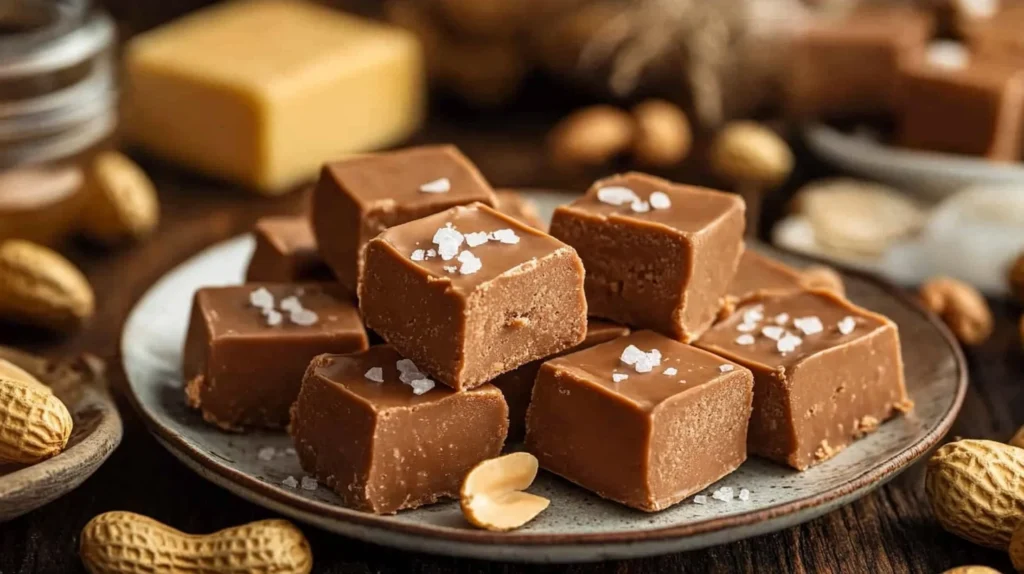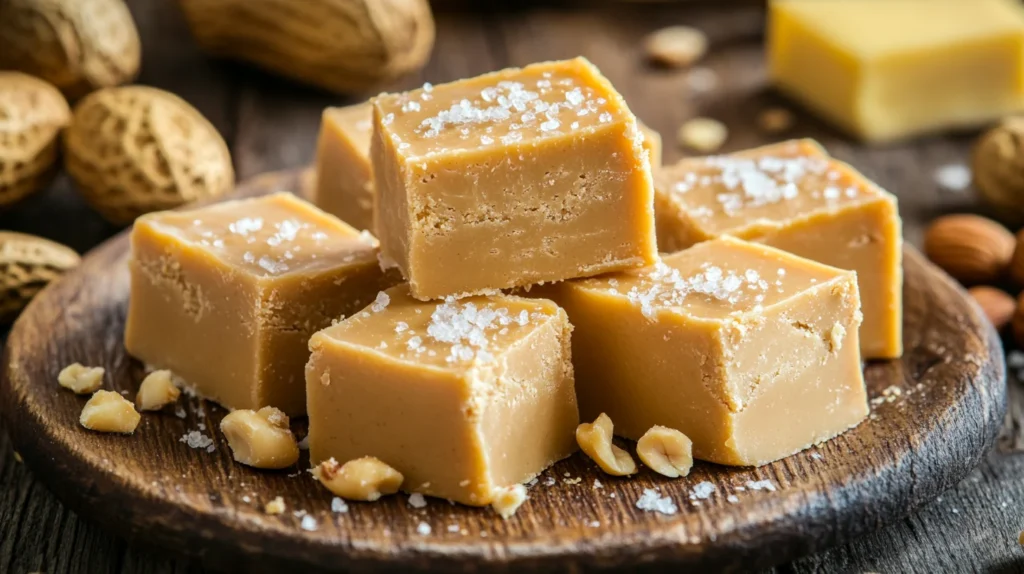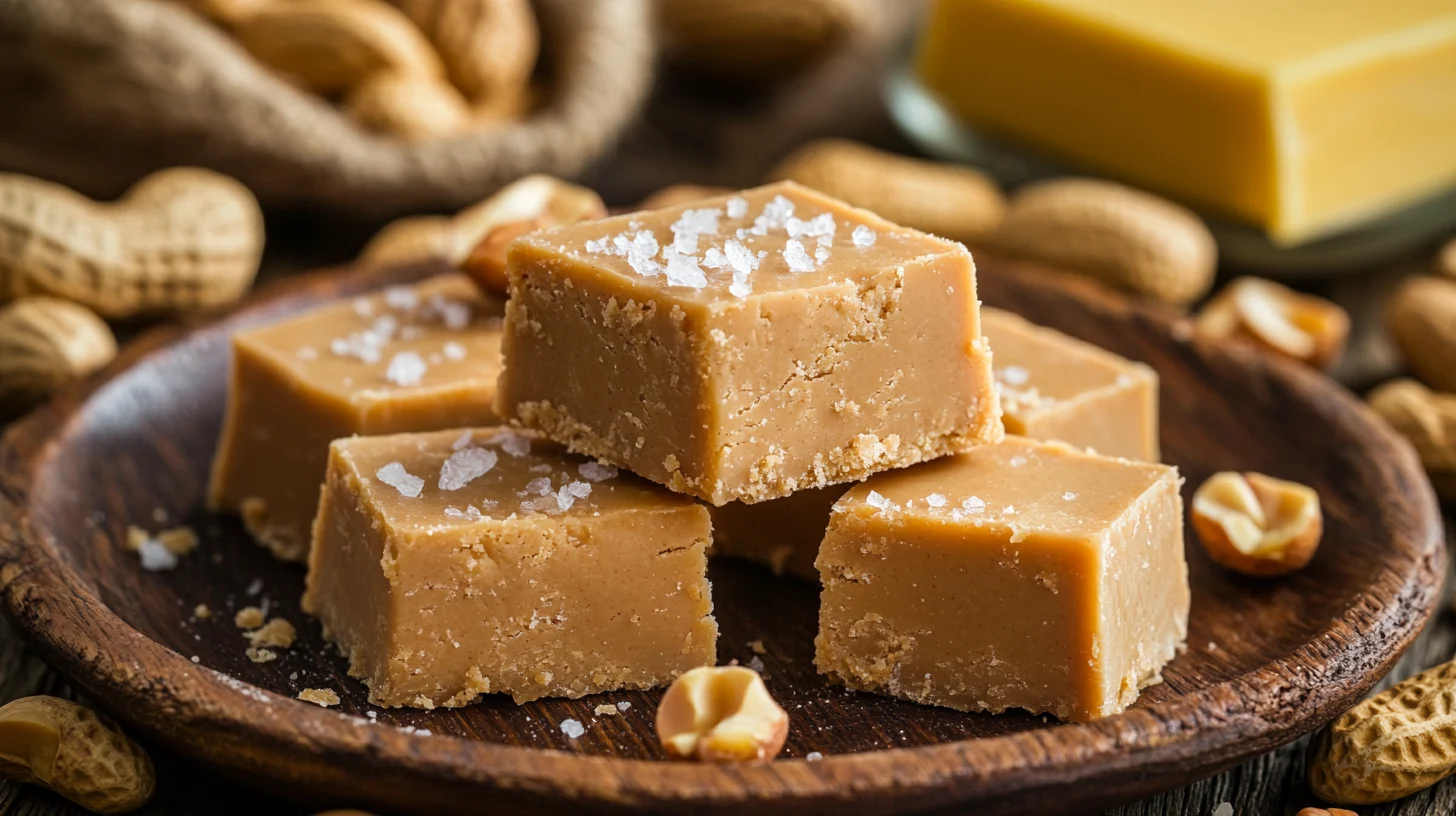Last updated on February 15th, 2025
If you’re searching for a sweet treat that’s quick to prepare and impossible to resist, look no further than this peanut butter fudge recipe. With just a few simple ingredients, you can create a decadent dessert that’s perfect for holidays, gifting, or indulging your peanut butter cravings. This fudge is creamy, rich, and versatile enough to adapt with your favorite flavors and toppings.
Peanut butter fudge isn’t just a dessert—it’s an experience. Pair it with a refreshing cup of tea or coffee for the ultimate comfort, or serve it alongside savory dishes like the Easy Meatloaf Recipe to create a perfectly balanced meal. For those who love exploring new dessert ideas, don’t miss this Cherry Cheesecake Recipe for another crowd-pleaser.
Table of contents

Ingredients You’ll Need
Creating the perfect peanut butter fudge begins with selecting the right ingredients. Each one plays a crucial role in achieving that smooth, melt-in-your-mouth texture.
Core Ingredients
- Peanut Butter: Use creamy peanut butter for a smooth texture, but chunky peanut butter works great if you love a little crunch in every bite.
- Butter: Both salted and unsalted butter work well. The butter adds richness and helps bind the fudge together.
- Sugar: Choose from granulated sugar for a classic sweet flavor, powdered sugar for an ultra-smooth consistency, or brown sugar for a hint of caramel.
- Vanilla Extract: A teaspoon of vanilla elevates the flavor and balances the sweetness.
Step-by-Step Instructions: How to Make Peanut Butter Fudge
1. Prepare Your Workspace
Preparation is key to making flawless fudge. Start by lining an 8×8-inch pan with parchment paper or lightly greasing it. This prevents sticking and makes it easier to remove the fudge once it has set. Measure out all your ingredients ahead of time to streamline the process, as fudge sets quickly once cooked.
2. Melt Butter and Sugar
In a medium-sized saucepan, melt ½ cup of butter over medium heat. Stir in 2 cups of sugar and ½ cup of milk (or heavy cream for extra richness). Continue stirring until the sugar is fully dissolved, and bring the mixture to a gentle boil. Allow it to boil for 2-3 minutes, stirring constantly to prevent scorching. If you have a candy thermometer, aim for a temperature of 234°F (soft ball stage).
3. Add Peanut Butter and Vanilla
Remove the saucepan from the heat and immediately stir in 1 cup of peanut butter. Mix quickly and thoroughly until the peanut butter is completely melted and incorporated into the sugar mixture. Add 1 teaspoon of vanilla extract and stir to combine. The mixture should be smooth and creamy.
4. Pour and Set
Pour the fudge mixture into the prepared pan, spreading it evenly with a spatula. For added texture and flavor, sprinkle sea salt, crushed nuts, or mini chocolate chips over the top before it sets. Allow the fudge to cool at room temperature for 2-3 hours, or refrigerate it for faster setting.
5. Cut and Serve
Once the fudge has fully set, use the parchment paper to lift it out of the pan. Cut it into squares or rectangles with a sharp knife. To achieve clean cuts, chill the fudge for 10 minutes before slicing and wipe your knife between cuts.
Creative Variations of Peanut Butter Fudge
One of the best things about peanut butter fudge recipes is their adaptability. You can easily transform the classic recipe into a variety of exciting flavors and textures to suit your preferences or special occasions.
1. Chocolate Swirl Peanut Butter Fudge
Chocolate and peanut butter are a match made in heaven, and this variation adds visual flair to the delicious combination. Melt ½ cup of chocolate chips (dark, milk, or white) in a microwave or double boiler. Drizzle the melted chocolate over the fudge mixture once it’s poured into the pan but before it sets. Use a toothpick or knife to gently swirl the chocolate into the peanut butter mixture, creating a marbled effect. For an extra indulgent touch, top with mini chocolate chips or crushed chocolate candies.
2. Healthier Peanut Butter Fudge
For a lighter, more health-conscious version, make simple substitutions while maintaining the creamy texture and delicious flavor. Replace granulated sugar with coconut sugar or a natural sweetener like maple syrup. Use natural peanut butter with no added sugars or oils for a purer flavor. Enhance the nutritional value by mixing in a tablespoon of chia seeds or ground flaxseeds. Add a touch of unsweetened cocoa powder for a hint of chocolate without extra sweetness.
3. Marshmallow Fluff Peanut Butter Fudge
For a light and airy texture, incorporate marshmallow creme into your peanut butter fudge. Stir 1 cup of marshmallow creme into the hot fudge mixture before pouring it into the pan. The marshmallow adds a subtle sweetness and creates a fluffier, almost cloud-like consistency. For added decadence, top with mini marshmallows or drizzle melted chocolate over the set fudge.
4. Festive Holiday Fudge
Turn your peanut butter fudge into a seasonal showstopper with colorful additions and fun toppings. For Christmas, sprinkle red and green holiday sprinkles over the top before the fudge sets. You can also mix in crushed peppermint candies for a refreshing twist. For Easter, add pastel-colored candies or top with mini chocolate eggs. Halloween, use orange and black sprinkles or mix in candy corn for a spooky touch. For Valentine’s Day, swirl in red food coloring and sprinkle heart-shaped candies or edible glitter on top.
5. Peanut Butter Cup Fudge
For an extra indulgent variation, incorporate peanut butter cups into your fudge. Chop up mini peanut butter cups and fold them into the fudge mixture before pouring it into the pan. Press additional chopped peanut butter cups on top as a garnish. Allow the fudge to set as usual.
6. Salted Caramel Peanut Butter Fudge
For a luxurious twist, add a layer of salted caramel to your peanut butter fudge. After pouring the peanut butter fudge mixture into the pan, drizzle warmed salted caramel sauce over the top. Use a toothpick to swirl the caramel into the fudge or leave it as a glossy top layer. Sprinkle with flaky sea salt for an elegant finish.
7. Nutty Crunch Peanut Butter Fudge
Add texture and flavor by incorporating your favorite nuts. Fold chopped peanuts, almonds, or pecans into the fudge mixture for a satisfying crunch. Toast the nuts beforehand for an extra depth of flavor. Sprinkle additional nuts over the top as a garnish before the fudge sets.

Tips for Perfect Fudge Every Time
- Use Fresh Ingredients: Fresh peanut butter and sugar ensure the best flavor and texture.
- Avoid Overheating: High heat can scorch the sugar or butter, leading to a gritty texture. Keep the heat low and consistent.
- Work Quickly: Once the peanut butter is added, the mixture sets fast. Be ready to pour it into the pan immediately.
- Store Properly: Store fudge in an airtight container at room temperature for up to 7 days, or freeze for up to 3 months.
Internal Linking Opportunities
Enhance your readers’ experience by linking to related recipes and guides within your site:
- The Best Granola Recipe: Mention this as a great topping option for adding crunch to your fudge.
- Cottage Cheese Flatbread Recipe: Suggest this as a savory pairing for a balanced dessert spread.
- Brookie Recipe: Highlight this as another must-try dessert for those who love indulgent sweets.
FAQs About Peanut Butter Fudge
What is the secret to good fudge?
The secret to good fudge lies in achieving the perfect consistency and balance of ingredients. Use high-quality butter and peanut butter for a rich flavor, and ensure the sugar is completely dissolved during cooking. Timing is crucial—cooking the mixture to the soft ball stage (234°F) ensures the fudge sets properly. Stirring continuously and evenly while heating prevents grainy textures. Additionally, allowing the fudge to cool naturally at room temperature instead of rushing the process helps retain its creamy texture.
Why won’t my peanut butter fudge harden?
If your fudge doesn’t harden, it’s likely due to undercooking the sugar mixture. The mixture needs to reach the soft ball stage (234°F) for it to set properly. Using a candy thermometer is helpful to ensure accuracy. Another reason could be an imbalance in the ingredients, such as using too much liquid or not enough sugar. If your fudge remains soft, refrigerating it can help it firm up. For future batches, pay close attention to the cooking time and temperature.
What is peanut butter fudge made of?
Peanut butter fudge typically contains a few simple ingredients: peanut butter, butter, sugar, and vanilla extract. These core ingredients combine to create a creamy and rich fudge. Some recipes include additional elements like marshmallow creme or condensed milk for added texture and sweetness. You can also customize the recipe with toppings or mix-ins like chocolate chips or nuts.
Is it better to use condensed milk or evaporated milk for fudge?
Both condensed milk and evaporated milk can be used in fudge, but they serve different purposes. Condensed milk is sweetened, making it ideal for fudge recipes that don’t require additional sugar. It creates a rich, creamy texture and simplifies the process. Evaporated milk, on the other hand, is unsweetened and often used in traditional fudge recipes where sugar is cooked with butter. The choice depends on the recipe and desired sweetness level. For peanut butter fudge, either can work, but condensed milk is often preferred for its convenience and added sweetness.
Why is my fudge grainy?
Grainy fudge occurs when sugar crystals form during cooking. This can happen if the sugar isn’t completely dissolved before boiling or if the mixture is stirred too vigorously once it starts to cool. To avoid this, heat the sugar mixture slowly and stir continuously while dissolving the sugar. Avoid overstirring after removing it from the heat. Using a candy thermometer to monitor the temperature can also help prevent crystallization.
Can I make fudge without a candy thermometer?
Yes, it’s possible to make fudge without a candy thermometer, but it requires careful attention. Look for visual and textural cues, such as the mixture thickening and reaching a soft, pliable consistency when dropped into cold water (the “soft ball stage”). However, for best results and consistency, a candy thermometer is highly recommended, especially for beginners.
How long does fudge last?
When stored properly, peanut butter fudge can last up to 7 days at room temperature in an airtight container. For extended storage, wrap the fudge tightly in plastic wrap or parchment paper and place it in a freezer-safe container. It can be frozen for up to 3 months. When ready to enjoy, thaw it at room temperature for an hour to regain its creamy texture.
Can I use natural peanut butter?
Yes, natural peanut butter works well in fudge recipes, but it requires some additional attention. Ensure the peanut butter is well-stirred to incorporate the natural oils, as separation can affect the texture. Natural peanut butter can create a slightly softer fudge, so consider refrigerating the mixture to help it set properly.
By understanding the key elements of a peanut butter fudge recipe and addressing these common issues, you’ll be well-equipped to make a batch of fudge that’s smooth, creamy, and perfectly delicious!
Conclusion
This peanut butter fudge recipe is the perfect combination of simplicity and indulgence. Whether you stick to the classic version or experiment with creative variations like chocolate swirls or marshmallow fluff, this treat is guaranteed to impress. Pair it with savory dishes like the Easy Meatloaf Recipe for a complete meal, or enjoy it as part of a dessert platter with recipes like the Brookie Recipe. No matter how you serve it, this peanut butter fudge will always be a crowd-pleaser!

